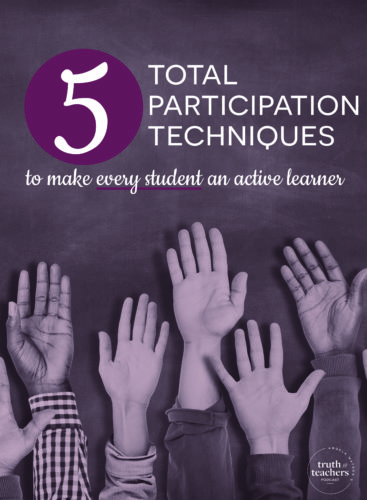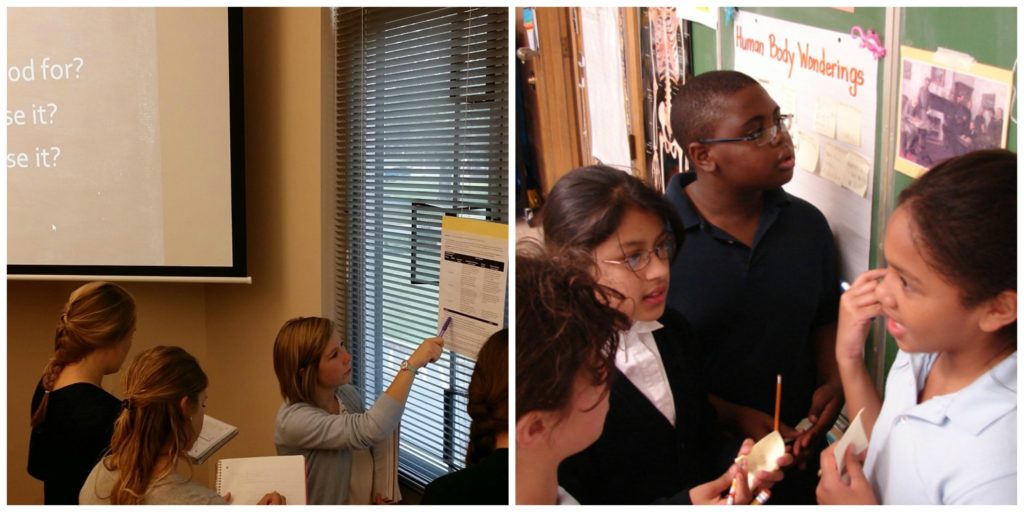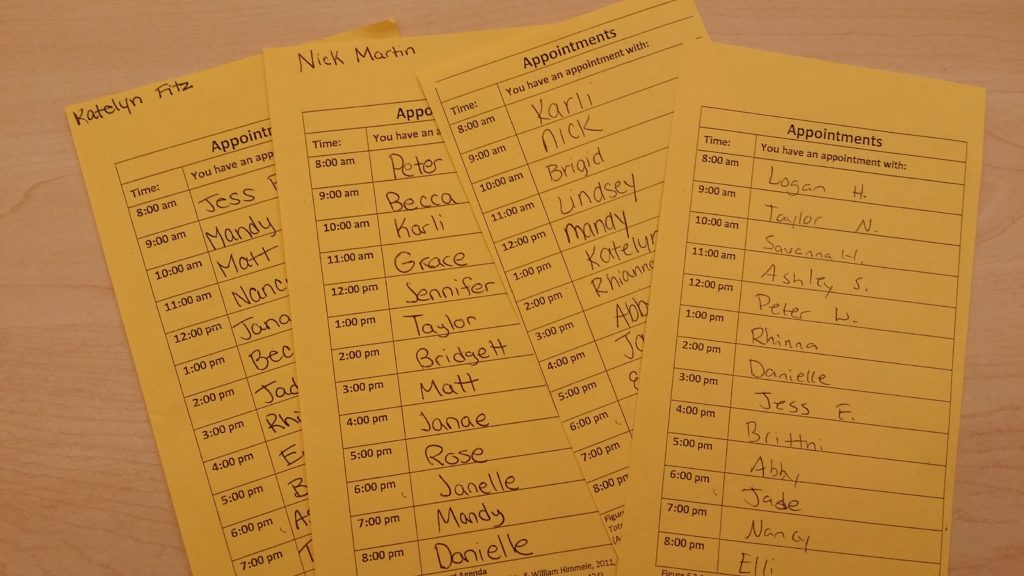 Persida and William Himmele are a husband-and-wife teacher team who have conducted over 500 presentations around the world and coauthored the book Total Participation Techniques: Making Every Student an Active Learner. They are both professors in the education department at Millersville University in Pennsylvania, and are passionate about designing cognitively engaging learning experiences.
Persida and William Himmele are a husband-and-wife teacher team who have conducted over 500 presentations around the world and coauthored the book Total Participation Techniques: Making Every Student an Active Learner. They are both professors in the education department at Millersville University in Pennsylvania, and are passionate about designing cognitively engaging learning experiences.
In this blog post and podcast episode, Persida Himmele joins us to explain what a total participation technique is and how teachers can provide access to higher-order thinking opportunities for all students. We’ll go through 5 specific examples which you can use in your classroom today.

Want to listen instead of read?
Listen to episode 103 below,
or subscribe in your podcast app.
What are Total Participation Techniques and why are they so important?
TPTs allow you to maximize the amount of learning that can take place by getting every student involved, instead of just calling on a few kids.
Persida explains, “They started off as a recommendation for teachers working with ELLs, to help students focus by keeping them accountable. The Total Participation Techniques are ways to get evidence that every single student is with you at the same time and ensure they’re using higher-order thinking.”
How “the ripple” can provide access to higher-order thinking opportunities for all students
“One of the things that we tend to fall back on as teachers is the traditional Q&A, where we shoot out a question, and basically whoever raises their hand gets to answer the question. Total Participation Techniques is flipping that,” says Persida.
Picture a ripple in the water. It starts with the initial plunk of a pebble in a pond, which would be every individual student being accountable to answering the question or prompt. From there, it ripples out into pairs or small groups, and then from there, the outer ripple of addressing the whole group with a traditional Q&A.
Persida explains that the ripple effect is especially important when we’re talking about higher-order thinking skills, because higher-order prompts require more time for students to process, particularly with kids who are shy, have special needs, are gifted, or are English language learners particularly. The ripple gives them time. “Total Participation Techniques are kind of all using that mentality where we first start with the individual, and then we ripple out.”
If you want to find out what students know, calling on them in class should be the last thing you do
Persida explains that there ARE instances when you can simply call on students, but not for higher-level thinking prompts that require more time to process.
“The whole idea behind The Ripple is that I am no longer just calling on a kid. When the question is something that I want every student to show me evidence that they understand, then calling on someone is going to be the last thing I do. I’m first going to want to get evidence from every individual student, and then I’m going to let them process it together quickly, and then it’s OK to call on them.
“When you call on a student, everyone else is off the hook. It’s really got to be a mindset of, ‘I want evidence that every student is learning. How am I going to do that?’ When it’s important enough for everyone to learn, you ought to make sure that every single student is going to give you that evidence.”
5 examples of Total Participation Techniques you can use right away
Figuring out if every student is learning can be simple. There are Total Participation Activities that will take a long time, and can even comprise the majority of the class period, but there are others that will take two minutes.
There are five chapters in the book, each one with a different type of Total Participation Technique. Here’s an explanation of each category, and an example of each.
-
On-the-Spot: Chalkboard Splash
Chalkboard Splash is an on-the-spot activity that doesn’t require any planning or paper. With the Chalkboard Splash, you just come up with your prompt and say to the students, “I want you to answer the prompt at your desk quickly.”
Have students boil their answer down to 15 words or less, and write it at their seats. When they’re ready, they can come up to the board and copy their response for the class to see. It usually takes about three minutes for all students to finish and trickle up to the board.
Persida says, “Typically we ask the students to look at what their peers have written and sum it up. What are some commonalities or big ideas that they see emerging from what others have written? They can also look for surprises. You can ask, ‘What are some things you didn’t really think of and you see that your peers have written down?'”
The Chalkboard Splash is “just a neat way to get a response and visualize or look at what your students are thinking about what you just taught. Use it whenever you find yourself thinking, ‘I wonder how they’re processing this.’ Sometimes I will have it written right into my lesson plans, but sometimes it’s just on-the-spot, a sort of ‘So what? How should we feel about this? What is the big idea here?’ The students take that big idea and put it in their own words, 15 words or less.”
-
Hold-Ups: True, Not True
Hold-Ups can be used from kindergarten through college whenever you have a set choice of options for a topic you’re discussing. Students have the different answer choices written down, and then they hold up the card for the one they choose.
As an example, Persida says, “One that we use a lot — you can use with anything — is the true, not true, true with modifications, and unable to determine for specific reasons. That fits anything, so those cards are already made up. We have little TPT zip close bags that have materials we always use, and that’s in there, because you never have to reprint those.
“So the idea is that you’re sort of thinking about the types of responses you can use for multiple activities, that way you don’t have to do this every time. Each of those four cards is already pre-printed, pre-cut, they’re inside a zip close baggie. The kids just pull out their baggie at the beginning of the activity, and then they can just hold up the card as you go through the questions.”
-
TPTs Involving Movement: Feature Walk
Movement perks students up so that they’re ready to listen for longer stretches of time, so Total Participation Techniques that involve movement (like the Feature Walk) can be really engaging. Persida explains, “When you find yourself with a text that has a lot of features, pictures, diagrams, maps, charts, tables, etc., that text would be an ideal chapter to use for a feature walk. We photocopy each of the features, so maybe there’s five, and we enlarge them to the size of a sheet of paper and we hang them on the wall.
“We divide up the class so that they each go to one of the features and we give them specific prompts that they need to respond to that are related to the features. Then we ring a bell after they’ve answered their prompts, and they move either clockwise or counterclockwise to the next feature. They’re looking at the feature, responding to prompts. What is the feature telling us? Why is it important? Why did the author include it? And then the bell rings and they go on to the next feature.”

During the Feature Walk, you might want to include sticky notes where students can respond. They simply leave the sticky notes there or on the back of their own papers, and then go ahead and rotate to the next feature.
Kids spend no more than five minutes in each spot of the rotation, and Persida says this “really helps them process what was meaty in the chapter, because oftentimes the features contain important information that kids don’t always stop and think about.”
-
Guiding Notetaking: Pause, Star, Rank
Pause, Star, Rank allows students to stop and look at all of their notes, and then put a star next to anything that is important. Students then take whatever they’ve starred, choose the top three, and rank them. That top-ranking item is oftentimes put into a Chalkboard Splash to share with the class.
Persida says, “I’ve done this with over 200 people at one time, and it’s really cool to see what they all thought was important. Each person has different take-aways.It gives you a lot of windows into a student’s thinking process and their personalities too. What do they value? What resonates with them? What connects for them? It’s very personal, and yet it gives them time that they needed to process.”
-
Wrap-ups: 1, 2, 3 O’Clock
The wrap-ups chapter of the Total Participation Techniques book has techniques that allow students to sum and reflect on the most essential components of what they’ve learned.
One example is called the 1, 2, 3 o’clock. Students use their “Appointment Agenda” to gather appointments. These are determined in advance, often on the first day of class with students, by having every student walk around and make appointments with each other. That way you can say at any point in the school year, “Meet up with your 2 p.m. appointment,” and the students already will be paired.

This gives you a quick and easy way to pair kids up with people they’re comfortable with, because they’ve chosen these 12 people. So if there’s someone in the room they’re not comfortable working with, those people won’t be on their clock. These are 12 people they have agreed to work with.
So to wrap up your lesson, you can tell students to get with a certain partner and reflect, sum up, complete an exit ticket, and so on.
Benefits of using Total Participation Techniques
- You aren’t wasting time try to figure out which students are learning during a lesson and which students are stuck, because the TPTs allow you to observe growth as it happens.
- It shifts classroom culture so that students are more comfortable with one another. Persida says her college students “have started talking to each other outside of the classroom as well, like in the hallways. It’s harder not to say hello to a student that you’ve talked to in class and you’ve had interactions with, so the classroom community was stronger.”
- You get more insight into students’ thoughts because students share more. This builds connection and rapport.
- The techniques counter teacher bias and help ensure equity in participation. Persida explains, “When you have only certain students answering your questions, the students who haven’t had a whole lot of success with school are not necessarily getting the same learning time that the others are. TPTs really do provide a simple way of getting more equity among students.”
You don’t need a ton of strategies–just pick a couple techniques and rotate them through your lessons!
I shared with Persida that I think a lot of teachers run into the trap of wanting a different activity or learning strategy for every lesson, and we both agreed that’s not necessary. I’ve found that if you have 10 to 15 strategies that you rotate through over and over, the kids learn and expect them, and then you’re not wasting time in class explaining and trying to make sure kids know what to do.
Having read the first edition of William and Persida’s book, my advice is to pick one or two strategies from each of the 5 categories, and put them into regular rotation in your teaching practice. Get the kids really familiar with them so they come naturally to you and your students, and then you can switch things up throughout the school year.
Persida adds, “We have a chapter in the second edition of the book about the most common pitfalls, and one that we see is where teachers are so enamored with an activity that they’ll force it. Instead, look at your goal. What is it you’re trying to teach? What is the content? And then choose the activity from that point. Oftentimes, it is the same activity you used yesterday.
It does not have to be 20 different things. It’s all about the learning. It’s not about the activity. Are they learning? And what evidence can you get that they’re learning? That’s really got to be key. It’s not the activity that’s going to do it. It’s your mindset, really, that whole shift of ‘show me that you learned it’.”
Learn more at TotalParticipationTechniques.com,
or check out the second edition of the book which was just released.
This post is based on an episode from my weekly podcast, Angela Watson’s Truth for Teachers. A podcast is like a free talk radio show you can listen to online, or download and take with you wherever you go. I release a new 15-20 minute episode each Sunday and feature it here on the blog to help you get energized and motivated for the week ahead.
The Truth for Teachers Podcast
Our weekly audio podcast is one of the top K-12 broadcasts in the world, featuring our writers collective and tons of practical, energizing ideas. Support our work by subscribing in your favorite podcast app–everything is free!
Explore all podcast episodes
Angela Watson
Founder and Writer
Sign up to get new Truth for Teachers articles in your inbox
Discussion
Leave a Reply
OR

Join our
community
of educators
If you are a teacher who is interested in contributing to the Truth for Teachers website, please click here for more information.




















I’m in the middle of reading this book right now. I love it, and I want to use the ideas, but now we’re doing Distance Learning! Any ideas ideas or resources on how to do this via Zoom? I’m thinking Jamboard and Breakout rooms in Zoom might work. I teacher 4th grade. Thanks in advance!
aave@lsc.k12.in.us
Please send templates wrap ups. THANKS!
5 total participation techniques to make every student an active learner
When I click on download materials for this episode – I get the message 404 on the link. How can I download the materials?
Interested